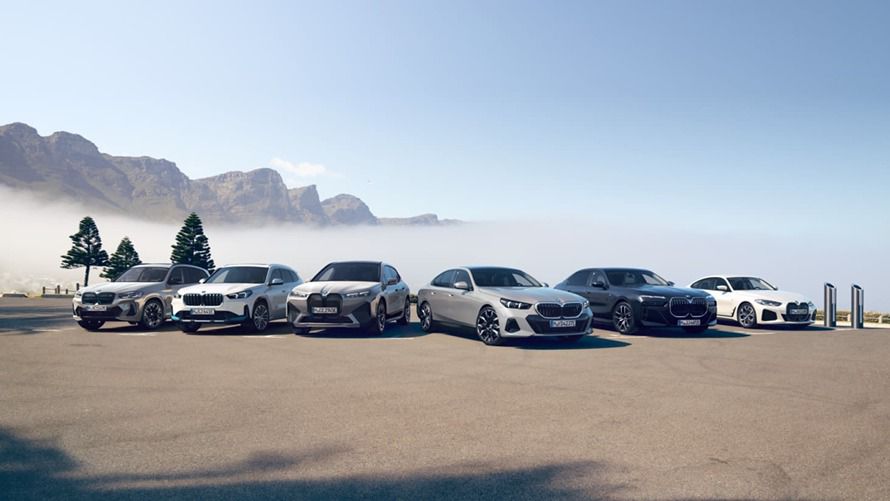Our tool for managing your permission to our use of cookies is temporarily offline. Therefore some functionality is missing.

THE XM
TECHNICAL DATA OF THE BMW XM AUTOMOBILES.
The BMW XM Automobiles – engines, facts and dimensions.
BMW XM AUTOMOBILES: TECHNICAL DATA.
- BMW XM Label Red
- BMW XM 50e
No search result found. Please try another input

| Engine type | Petrol - plug-in hybrid |
|---|---|
| Power in kW (hp) | 550 (748) [10] |
| Torque in Nm | 1000 [10] |
| Transmission | 8-speed, automatic |
| Drivetrain | All-wheel drive |
| Cylinders | 8 |
|---|---|
| Displacement in cm³ | 4395 |
| Nominal power in kW (hp)/1/min | 430 (585)/5600-6500 |
| Nominal torque in Nm/1/min | 750/1800-5400 |
| (Nominal) power/30 minutes power in kW (hp) | 145 (197)/57(- [10]) |
|---|---|
| (Nominal) torque in Nm | 280 |
| Acceleration 0–100 km/h in s | 3.8 |
|---|---|
| Maximum speed in km/h | 290 |
| Electric top speed in km/h | 140 |
| Fuel consumption, combined WLTP in l/100 km [6] | 2.0-1.6 |
|---|---|
| CO2 emissions, combined WLTP in g/km [6] | 45-35 |
| Energy consumption, combined WLTP in kWh/100 km [6] | 33.5-32.5 |
| Electric range, WLTP in km [7] | 76-82 |
| Battery capacity in kWh | 25.7 |
|---|---|
| Maximum charging power AC/DC in kW | 7.4/- |
| Charging time DC 10–80% in min | - |
| Charging time AC 0–100% in h | 4.50 |
| Length/width/height in mm | 5110/2005/1755 |
|---|---|
| Wheelbase in mm | 3105 |
| Curb weight in kg [9] | 2795 |
| Luggage capacity in l | 527-1820 |
| Fuel capacity in l | 69 |
| Optionally delivered with support for trailer load, braked, up to 12%/towbar download in kg | 2700/140 |
| Engine type | Petrol - plug-in hybrid |
|---|---|
| Power in kW (hp) | 350 (476) [9] |
| Torque in Nm | 700 [9] |
| Transmission | 8-speed, automatic |
| Drivetrain | All-wheel drive |
| Cylinders | 6 |
|---|---|
| Displacement in cm³ | 2995 |
| Nominal power in kW (hp)/1/min | 230 (313)/5000-6500 |
| Nominal torque in Nm/1/min | 450/1750-4700 |
| (Nominal) power/30 minutes power in kW (hp) | 145 (197)/57 (- [10]) |
|---|---|
| (Nominal) torque in Nm | 280 (450[11]) |
| Acceleration 0–100 km/h in s | 5.1 |
|---|---|
| Maximum speed in km/h | 250 |
| Electric top speed in km/h | 140 |
| Fuel consumption, combined WLTP in l/100 km [6] | 1.7-1.3 |
|---|---|
| CO2 emissions, combined WLTP in g/km [6] | 37-30 |
| Energy consumption, combined WLTP in kWh/100 km [6] | 32.2-31.5 |
| Electric range, WLTP in km [7] | 78-84 |
| Battery capacity in kWh | 25.7 |
|---|---|
| Maximum charging power AC/DC in kW | 7.4/- |
| Charging time DC 10–80% in min | - |
| Charging time AC 0–100% in h | 4.50 |
| Length/width/height in mm | 5110/2005/1755 |
|---|---|
| Wheelbase in mm | 3105 |
| Curb weight in kg [9] | 2695 |
| Luggage capacity in l | 527-1820 |
| Fuel capacity in l | 69 |
| Optionally delivered with support for trailer load, braked, up to 12%/towbar download in kg | 2700/140 |
FUEL CONSUMPTION AND CO2 EMISSIONS.
BMW XM Label Red[1], [4], [5], [6], [7]:
Fuel consumption, combined WLTP in l/100 km: 2.0-1.6
CO2 emissions, combined WLTP in g/km: 45–35
Energy consumption, combined WLTP in kWh/100 km: 33.5–32.5
Overseas model shown. XM Label Red available only in New Zealand.
The values of fuel consumptions, CO2 emissions and energy consumptions shown were determined according to the European Regulation (EC) 715/2007 in the version applicable at the time of type approval. The figures refer to a vehicle with basic configuration in Germany and the range shown considers optional equipment and the different size of wheels and tires available on the selected model.
The CO2 efficiency specifications are determined according to Directive 1999/94/EC and the European Regulation in its current version applicable. The values shown are based on the fuel consumption, CO2 values and energy consumptions according to the NEDC cycle for the classification.
When charging times are shown they can be affected by a number of factors such as type of charger, voltage supplied to the charger/car and type of current (AC or DC) supplied to the charger/car. The car also plays a role in charging times as it can be set by the driver to accept various different amperage and should preconditioning be used to heat or cool the vehicle while charging this will also affect the charging time.
The basis for the calculation of the charging times for 100 km range is the electric consumption of the vehicle based on the use of a high-Powered Charging station (HPC) or charging type and current as indicted in the literature above. The testing procedure measures are based on a 23 degrees Celsius battery start and ambient temperature with certification values excluding additional auxiliary consuming devices and systems within the vehicle such as seat heating, displays, air conditioning.
Individual consumption (fuel economy) may differ due to driving profile, vehicle load profile, auxiliary consumer usage, temperature, and ambient conditions. Consumption is based on WLTP or NEDC (whichever is indicated) best case conditions and is independently tested for BMW Group. If you are comparing this range with other models or brands make sure they are stating the same WLTP or NEDC testing regime. These results can be used to compare vehicles on a close to “like for like” basis but are unlikely to be achieved in real world conditions for reasons including temperature variation, driving conditions and the use of the auxiliary systems referred to above.
Information provided and images displayed on this site include overseas models and may show some features not available in New Zealand. Please contact an authorised BMW dealer for specific information on vehicles and features available in New Zealand. Product changes may have been made since production of this content.
The figures for performance, consumption and CO2 emissions refer to vehicles with standard transmission. Values in square brackets apply to vehicles with automatic transmission.
[1] For plug-in hybrid: At temperatures below freezing, the fully electric drive system is only available after a few kilometres of driving, once the battery has heated to operational temperature.
[2] Provisional figures; any missing figures were unavailable at the time of publication.
[3] Performance data of petrol engines apply to vehicles using RON 98 fuel. Fuel consumption data apply to vehicles using reference fuels in accordance with EU Regulation 715/2007. Unleaded RON 91 and higher with a maximum ethanol content of 10% (E10) may also be used. BMW recommends RON 95 fuel. For high-performance automobiles, BMW recommends RON 98 fuel.
[4] For plug-in hybrid: Electric drive depending on battery charging level.
[5] "Official data for fuel consumption, CO2 emissions, power consumption and electric range was determined in accordance with the prescribed measuring procedure and corresponds to European Regulation (EC) 715/2007 in the applicable version. For ranges, data determined as per WLTP takes into account any optional equipment (available on the German market in this case). For vehicles that have been newly type approved since 1 January 2021, only the official data according to WLTP exists. In addition, NEDC values are deleted from the certificates of conformity as of 1 January 2023 by EC regulation 2022/195. For more information about NEDC and WLTP measuring procedures visit www.bmw.com/wltp
Further information about fuel consumption and official model-specific CO2 emissions of new passenger cars can be found in the ""Guideline for fuel consumption, CO2 emissions and electric power consumption for new passenger cars"", available free of charge at all points of sale, at the Deutsche Automobil Treuhand GmbH (DAT), Hellmuth-Hirth-Str. 1, 73760 Ostfildern-Scharnhausen, Germany, and under https://www.dat.de/co2/."
[6] For plug-in hybrid: Weighted, combined (EC AC Charge Weighted)
[7] Range depends on various factors, in particular: individual driving style, route characteristics, outside temperature, heating/air conditioning, pre-conditioning.
[8] The charging performance depends on the state of charge, ambient temperature, individual driving profile and use of auxiliary consumers. The ranges shown are based on the WLTP best case. The charging times apply to ambient temperatures of 23 degrees Celsius after a preceding drive and may differ depending on the usage behaviour.
[9] The EC unladen weight refers to a vehicle with standard equipment and does not include any optional extras. The unladen weight includes a 90% full tank and a driver weight of 75 kg. Optional equipment may affect the weight of the vehicle, the payload and the top speed if the selected equipment has an impact on the vehicle's aerodynamics.
[10] Composed of combustion engine drive (specified nominal value) and electric drive (up to specified nominal value). Electric drive depending on battery charging level.
[11] With optional M Drivers Package.
[12] With pre-transmission on crankshaft.

